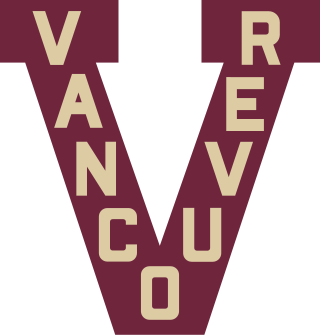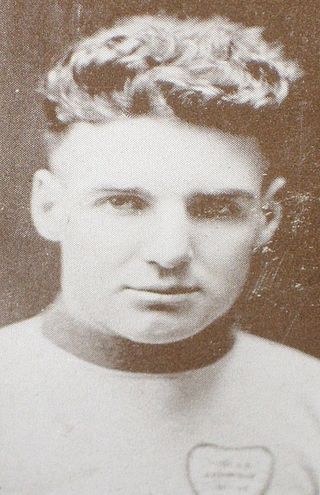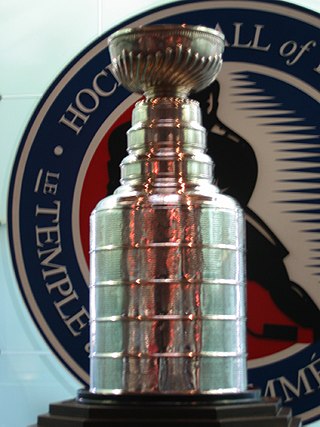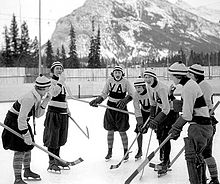
Ice hockey is a team sport played on ice skates, usually on an ice skating rink with lines and markings specific to the sport. It belongs to a family of sports called hockey. Two opposing teams use ice hockey sticks to control, advance, and shoot a vulcanized rubber hockey puck into the other team's net. Each goal is worth one point. The team with the highest score after an hour of playing time is declared the winner; ties are broken in overtime or a shootout. In a formal game, each team has six skaters on the ice at a time, barring any penalties, including a goaltender. It is a full contact game and one of the more physically demanding team sports.
The golden goal is a sports rule used in association football, Australian rules football, bandy, field hockey, ice hockey, lacrosse, and rugby league to decide the winner of a match in which scores are equal at the end of regular time. It is a type of sudden death. Under this rule, the game ends when a goal or point is scored; the team that scores that goal or point during extra time is the winner. Introduced formally in 1993, though with some history before that, the rule ceased to apply to most FIFA-authorized football games in 2004. The similar silver goal supplemented the golden goal between 2002 and 2004.

Curtis Lester Patrick was a Canadian professional ice hockey player and coach associated with the Victoria Aristocrats/Cougars of the Pacific Coast Hockey Association, and the New York Rangers of the National Hockey League (NHL). Along with his brother Frank Patrick and father Joseph Patrick, he founded the PCHA and helped develop several rules for the game of hockey. Patrick won the Stanley Cup six times as a player, coach and manager.
The Pacific Coast Hockey Association (PCHA) was a professional ice hockey league in western Canada and the western United States, which operated from 1911 to 1924 when it then merged with the Western Canada Hockey League (WCHL). The PCHA was considered to be a major league of ice hockey and was important in the development of the sport of professional ice hockey through its innovations.

The Vancouver Millionaires were a professional ice hockey team that competed in the Pacific Coast Hockey Association and the Western Canada Hockey League between 1911 and 1926. Based in Vancouver, British Columbia, they played in Denman Arena, the first artificial ice surface in Canada and the largest indoor ice rink in the world at the time it opened.
The Seattle Metropolitans were a professional ice hockey team based in Seattle, Washington, playing in the Pacific Coast Hockey Association (PCHA) from 1915 to 1924. During their nine seasons, the Metropolitans were the PCHA's most successful franchise, as they went 112–96–2 in their nine years as a franchise. The Metropolitans also won the most regular season PCHA championships, winning five times, with Seattle finishing second on three other occasions. The Metropolitans played their home games at the 2,500 seat Seattle Ice Arena located downtown at 5th and University.

Pacific Coliseum, locally known as The Coliseum or the Rink on Renfrew, is an indoor arena located at Hastings Park in Vancouver, British Columbia. Its main use has been for ice hockey and the arena has been the home for several ice hockey teams.

Édouard Cyrille "Newsy" Lalonde was a Canadian professional ice hockey forward in the National Hockey League (NHL) and a professional lacrosse player. Lalonde is regarded as one of hockey's and lacrosse's greatest players of the first half of the 20th century and one of Canadian sport's most colourful characters. He played for the Montreal Canadiens – considered to be the original "Flying Frenchman" – in the National Hockey Association and the NHL. As player-coach, Lalonde led the Canadiens to their first Stanley Cup in 1916. His goal-scoring prowess in the 1919 Stanley Cup playoffs set three NHL records that remain unbroken over a century later. He also played for the WCHL's Saskatoon Sheiks.

Cecil Henry "Babe" Dye was a Canadian professional ice hockey forward who played 11 seasons in the National Hockey League (NHL) for the Toronto St. Patricks/Maple Leafs, Hamilton Tigers, Chicago Black Hawks, and the New York Americans between 1919 and 1930. Born in Hamilton, Ontario, Dye was known as an excellent stick-handler and goal-scorer.

Francis Alexis Patrick was a Canadian professional ice hockey player, head coach, manager, and executive. Along with his brother Lester, he founded the Pacific Coast Hockey Association (PCHA), the first major professional hockey league in Western Canada. Patrick, who also served as president of the league, took control of the Vancouver Millionaires, serving as a player, coach, and manager of the team. It was in the PCHA that Patrick would introduce many innovations to hockey that remain today, including the blue line, the penalty shot, and tracking assists, among others.

Meghan Christina Agosta is a Canadian women's ice hockey forward, who last played for the Montreal Stars of the Canadian Women's Hockey League. Agosta played for the Canada women's national ice hockey team and is a three-time gold medallist from the 2006, 2010 and 2014 Winter Olympics. At the 2010 Winter Olympics, Agosta was named MVP of the Women's Hockey Tournament. She is a multi-medallist at the Women's World Championships with two gold medals and six silvers.
The 1922–23 Ottawa Senators season was the club's 38th season of play and sixth season in the NHL. They were coming off a disappointing playoff run in 1922, as they lost to the Toronto St. Pats in the NHL finals in a close, hard-fought series. The Senators would finish first in the standings, defeat Montreal in the playoffs, defeat Vancouver in the Stanley Cup semi-finals and defeat Edmonton to win their tenth Stanley Cup title.
The 1922 Stanley Cup Finals was contested by the National Hockey League (NHL) champion Toronto St. Patricks and the Pacific Coast Hockey Association (PCHA) champion Vancouver Millionaires. The St. Pats defeated Vancouver three games to two in the best-of-five game series to win their only Stanley Cup as the St. Pats.

The 1921–22 PCHA season was the 11th season of the professional men's ice hockey Pacific Coast Hockey Association league. Season play ran from December 5, 1921, until February 24, 1922. The season was enlarged to 24 games per team. The Seattle Metropolitans were the regular-season PCHA champions, but lost the play-off with Vancouver Millionaires.
The 1921–22 Toronto St. Patricks season was the fifth season of the Toronto NHL franchise, third as the St. Patricks. The St. Patricks would win the NHL championship and the Stanley Cup.

The men's tournament in ice hockey at the 2010 Winter Olympics was held in Vancouver, British Columbia, Canada, from February 16 to February 28, 2010. Games were hosted at two venues – Canada Hockey Place and UBC Thunderbird Arena. These Olympics were the first to take place in a city with a National Hockey League team since the NHL players were introduced in 1998, which meant players on the Vancouver Canucks who were competing in the Olympics were playing in their home arena: Roberto Luongo for Canada, Ryan Kesler for the United States, Pavol Demitra for Slovakia, Sami Salo for Finland, Christian Ehrhoff for Germany, and Daniel and Henrik Sedin for Sweden.

The first instances of organized women's ice hockey in Canada date back to the 1890s when it was played at the university level. The Women's Hockey Association claims that the city of Ottawa, Ontario hosted the first game in 1891. In 1920, Lady Meredith, an avid sportswoman and wife of Sir Vincent Meredith of Montreal donated the Lady Meredith Cup to the Quebec Ladies' Hockey Association, said to be the first women's ice hockey trophy created for a competition in Canada. At the time women competed in ankle-length skirts.

The Fernie Swastikas were a women's hockey team that was formed in 1922 in Fernie, British Columbia. Their uniform used as a symbol the swastika, which before World War II was a common religious symbol, and especially a sun sign. In 1923, the Swastikas won the Alpine Cup at the Banff Winter Carnival women's ice hockey championship. There were two other teams called the Swastikas, one in Edmonton, Alberta, and another the Windsor Swastikas of Windsor, Nova Scotia.

The 1983 Stanley Cup playoffs, the playoff tournament of the National Hockey League (NHL) began on April 5, after the conclusion of the 1982–83 NHL season. The playoffs concluded on May 17 with the champion New York Islanders defeating the Edmonton Oilers 4–0 to win the final series four games to none and win the Stanley Cup for the fourth consecutive season.

The Penn State Women's Ice Hockey Club represents Penn State University (PSU) in Women's Division 1 of the American Collegiate Hockey Association (ACHA) and in the Central Collegiate Women's Hockey Association (CCWHA). Since the team's establishment in 2012, it has been very successful, including a pair of ACHA second-place finishes at the Division 2 level in 2012–13 and 2013–14 and an appearance at the ACHA Division 1 national championship tournament to close the 2014–15 season. PSU is one of just three teams to appear in consecutive ACHA Division 2 championship games, joining the University of Minnesota-Duluth (2007–08) and Rainy River Community College (2008–11).















